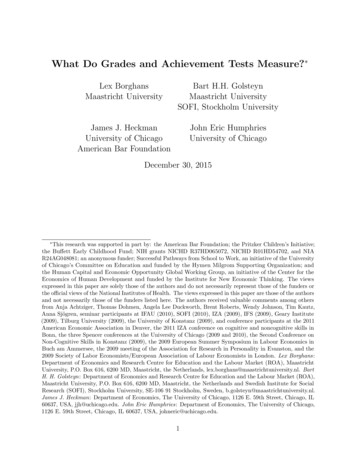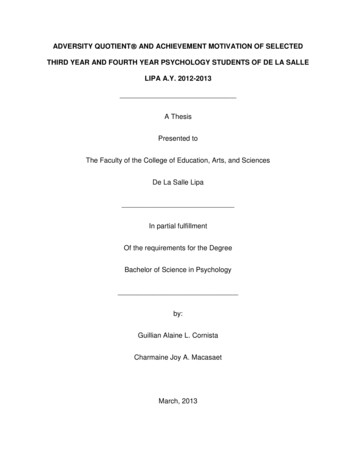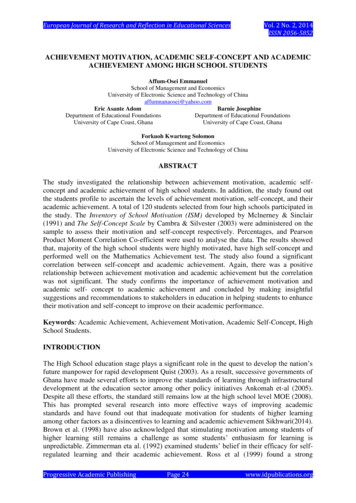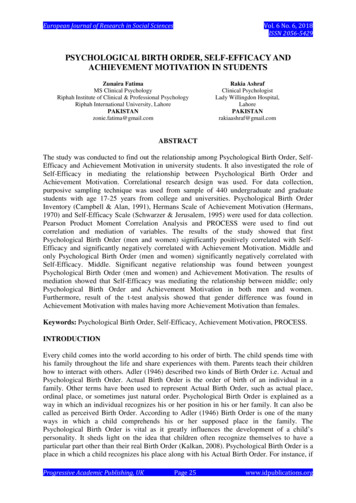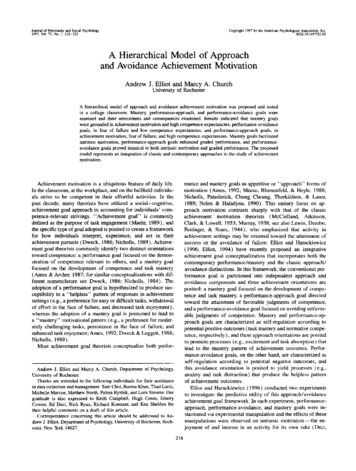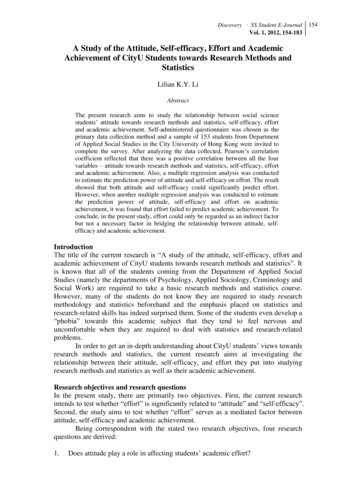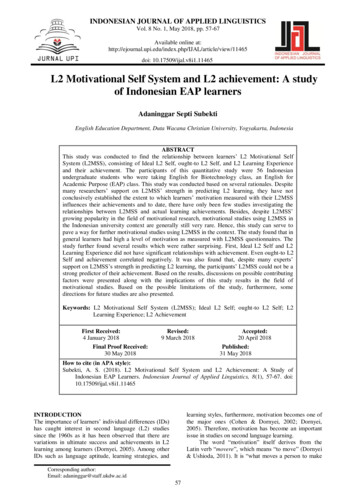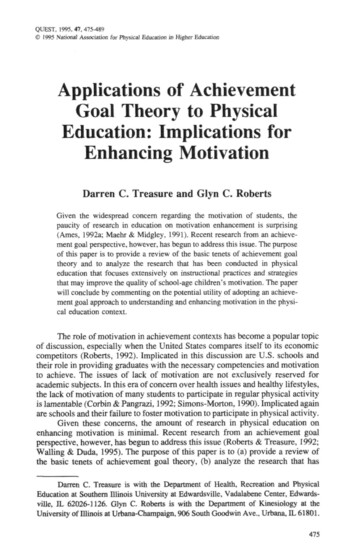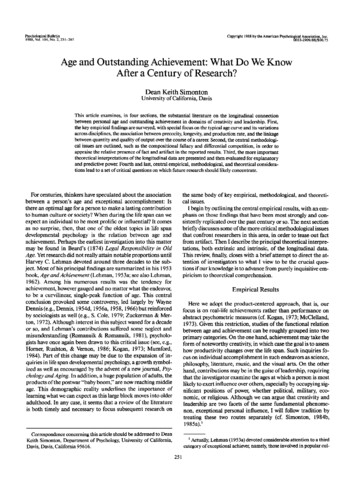
Transcription
Psychological Bulletin1988, Vol. 104, No. 2, 251-267Copyright 1988 by the American Psychological Association, Inc.0033-2909/88/ 00.75Age and Outstanding Achievement: What Do We KnowAfter a Century of Research?Dean Keith SimontonUniversity of California, DavisThis article examines, in four sections, the substantial literature on the longitudinal connectionbetween personal age and outstanding achievement in domains of creativity and leadership. First,the key empirical findings are surveyed, with special focus on the typical age curve and its variationsacross disciplines, the association between precocity, longevity,and production rate, and the linkagebetween quantity and quality of output over the course of a career. Second, the central methodological issues are outlined, such as the compositional fallacy and differential competition, in order toappraise the relative presence of fact and artifact in the reported results. Third, the more importanttheoretical interpretations of the longitudinal data are presented and then evaluated for explanatoryand predictive power. Fourth and last, central empirical, methodological, and theoretical considerations lead to a set of critical questions on which future research should likely concentrate.For centuries, thinkers have speculated about the associationbetween a person's age and exceptional accomplishment: Isthere an optimal age for a person to make a lasting contributionto human culture or society? When during the life span can weexpect an individual to be most prolific or influential? It comesas no surprise, then, that one of the oldest topics in life spandevelopmental psychology is the relation between age andachievement. Perhaps the earliest investigation into this mattermay be found in Beard's (1874) Legal Responsibility in OldAge. Yet research did not really attain notable proportions untilHarvey C. Lehman devoted around three decades to the subject. Most of his principal findings are summarized in his 1953book, Age and Achievement (Lehman, 1953a; see also Lehman,1962). Among his numerous results was the tendency forachievement, however gauged and no matter what the endeavor,to be a curvilinear, single-peak function of age. This centralconclusion provoked some controversy, led largely by WayneDennis (e.g., Dennis, 1954d, 1956a, 1958, 1966) but reinforcedby sociologists as well (e.g., S. Cole, 1979; Zuckerman & Merton, 1972). Although interest in this subject waned for a decadeor so, and Lehman's contributions suffered some neglect andmisunderstanding (Romanuik & Romanuik, 1981), psychologists have once again been drawn to this critical issue (see, e.g.,Homer, Rushton, & Vernon, 1986; Kogan, 1973; Mumford,1984). Part of this change may be due to the expansion of inquiries in life span developmental psychology, a growth symbolized as well as encouraged by the advent of a new journal, Psychology andAging. In addition, a huge population of adults, theproducts of the postwar "baby boom," are now reaching middleage. This demographic reality underlines the importance oflearning what we can expect as this large block moves into olderadulthood. In any case, it seems that a review of the literatureis both timely and necessary to focus subsequent research onthe same body of key empirical, methodological, and theoretical issues.I begin by outlining the central empirical results, with an emphasis on those findings that have been most strongly and consistently replicated over the past century or so. The next sectionbriefly discusses some of the more critical methodological issuesthat confront researchers in this area, in order to tease out factfrom artifact. Then I describe the principal theoretical interpretations, both extrinsic and intrinsic, of the longitudinal data.This review, finally, closes with a brief attempt to direct the attention of investigators to what I view to be the crucial questions if our knowledge is to advance from purely inquisitive empiricism to theoretical comprehension.E m p i r i c a l ResultsHere we adopt the product-centered approach, that is, ourfocus is on real-life achievements rather than performance onabstract psychometric measures (cf. Kogan, 1973; McCleUand,1973). Given this restriction, studies of the functional relationbetween age and achievement can be roughly grouped into twoprimary categories. On the one hand, achievement may take theform of noteworthy creativity, in which case the goal is to assesshow productivity changes over the life span. Such inquiries focus on individual accomplishment in such endeavors as science,philosophy, literature, music, and the visual arts. On the otherhand, contributions may be in the guise of leadership, requiringthat the investigator examine the ages at which a person is mostlikely to exert influence over others, especially by occupying significant positions of power, whether political, military, economic, or religious. Although we can argue that creativity andleadership are two facets of the same fundamental phenomenon, exceptional personal influence, I will follow tradition bytreating these two routes separately (cf. Simonton, 1984b,1985a)JCorrespondence concerning this article should be addressed to DeanKeith Simonton, Department of Psychology, University of California,Davis, Davis, California 95616.Actually, Lehman (1953a) devoted considerable attention to a thirdcategory of exceptional achiever, namely, those involved in popular cul251
252DEAN KEITH SIMONTONCreativityEver since Lehman (1953a), life span developmental studiesof creative achievement have centered on three core topics: (a)the age curve that specifies how creative output varies over thecourse of a career, (b) the connection between productive precocity, longevity, and rate of output, and (c) the relation betweenquantity and quality of output (i.e., between "productivity" and"creativity").Age curves. One empirical generalization appears to be fairlysecure: If one plots creative output as a function of age, productivity tends to rise fairly rapidly to a definite peak and thereafterdecline gradually until output is about half the rate at the peak(see, e.g., S. Cole, 1979; Dennis, 1956b, 1966; Lehman, 1953a;but see Diamond, 1986). In crude terms, if one tabulates thenumber of contributions (e.g., publications, paintings, compositions) per time unit, the resulting longitudinal fluctuationsmay be described by an inverted backward-J curve (Simonton,1977a). Expressed more mathematically, productive output,say p(t), over a career tends to be roughly approximated by asecond-order polynomial of the formp(t) b bzt b3t 2,(1)where the bs are unstandardized regression coefficients obtained by regressing productivity at time t on linear and quadratic functions oft (see, e.g., Bayer & Dutton, 1977; Homer etal., 1986; Simonton, 1977a, 1980c). Typically, bl, or the intercept term, will be zero or slightly positive, bz will be positive orzero, and b3 will invariably be negative. In applying this equation, the independent variable, t, is not chronological age butrather career or professional age, where t 0 at the onset of thecareer (see Bayer & Dutton, 1977; Lyons, 1968). However, inpractice, chronological age is often used in lieu of career age,a substitution justified by their high correlation (e.g., r .87,according to Bayer & Dutton, 1977).By taking the first derivative of Equation 1, setting it equal tozero, and solving for t, one can easily show that the peak is expected to appear at one half of the ratio of the third and secondregression coefficients (i.e., at t -b2/2b3). However, it must beemphasized that the equation presented above is merely a firstapproximation, and it becomes particularly inadequate shouldwe attempt to extrapolate to extreme age ranges. Specifically,beyond a certain value of t, the predicted level of productivitybecomes negative, a meaningless outcome if output is gaugedby single contributions or items. 2 Instead, the curve tends toapproach the zero productivity rate more or less asymptotically,a tendency that implies that a third-order polynomial in timemay fit the data more precisely (Simonton, 1984a). The addition of further terms would also serve to remove another faultof a simple quadratic, namely, that it implies that the pre- andpostpeak slopes are roughly equal, which is seldom true in fact(el. Diemer, 1974). Nevertheless, over most ranges of careerages, Equation 1 provides a close enough fit that the additionture, such as sports and entertainment, who could be styled "celebrities" rather than creators or leaders (cf. Simonton, 1986b). Because theempirical research here is less extensive, and because the pertinent developmental variables are probably different, this type of distinction willnot be examined in this review.of a cubic term (t 3) rarely yields a significant increment to theexplained variance (Simonton, 1977a, 1984a; cf. Bayer & Dutton, 1977; Simonton, in press).Independent of the proper mathematical specification, twonecessary qualifications must still be imposed on the empiricalgeneralization just given. In the first place, the location of thepeak, as well as the magnitude of the postpeak decline, tends tovary depending on the domain of creative achievement. At oneextreme, some fields are characterized by relatively early peaks,usually around the early 30s or even late 20s in chronologicalunits, with somewhat steep descents thereafter, so that the output rate becomes less than one-quarter the maximum. This agewise pattern apparently holds for such endeavors as lyric poetry,pure mathematics, and theoretical physics, for example (Adams, 1946; Dennis, 1966; Lehman, 1953a; Moulin, 1955; Roe,1972b; Simonton, 1975a; Van Heeringen & Dijkwel, 1987). Atthe contrary extreme, the typical trends in other endeavors maydisplay a leisurely rise to a comparatively late peak, in the late40s or even 50s chronologically, with a minimal if not largelyabsent drop-off afterward. This more elongated curve holds forsuch domains as novel writing, history, philosophy, medicine,and general scholarship, for instance (Adams, 1946; Richard A.Davis, 1987; Dennis, 1966; Lehman, 1953a; Simonton, 1975a).Of course, many disciplines exhibit age curves somewhat between these two outer limits, with a maximum output ratearound chronological age 40 and a notable yet moderate declinethereafter (see, e.g., Fulton & Trow, 1974; Hermann, 1988; McDowell, 1982; Zhao & Jiang, 1986). Output in the last yearsappears at about half the rate observed in the peak years. Productive contributions in psychology, as an example, tend toadopt this temporal pattern (Homer et al., 1986; Lehman,1953b; Over, 1982a, 1982b; Zusne, 1976).It must be stressed that these interdisciplinary contrasts donot appear to be arbitrary but instead have been shown to beinvariant across different cultures and distinct historical periods (Lehman, 1962). As a case in point, the gap between theexpected peaks for poets and prose authors has been found inevery major literary tradition throughout the world and for bothliving and dead languages (Simonton, 1975a). Indeed, becausean earlier productive optimum means that a writer can dieyounger without loss to his or her ultimate reputation, poetsexhibit a life expectancy, across the globe and through history,about a half dozen years less than prose writers do (Simonton,1975a). This cross-cultural and transhistorical invariancestrongly suggests that the age curves reflect underlying psychological universals rather than arbitrary sociocultural determinants. In other words, the age functions for productivity mayresult from intrinsic information-processing requirementsrather than extrinsic pressures due to age stereotypes aboutolder contributors, a point that we shall return to in the theoretical section (see also Bayer & Dutton, 1977).The second qualification has to do with the occurrence of asingle-peak longitudinal function, for some investigators haveindicated the appearance of a more complex age curve with twoseparate peaks. Such double-peak curves are of two types. Mostcommon, perhaps, is the emergence of a secondary upswing in2 By using the quadratic formula, p(t) 0 when t [-b2 ( b 2 2 4b b3)l/2]/2b3, and p(t) 0 whenever t is extrapolated beyond this interval.
AGE AND OUTSTANDING ACHIEVEMENTcreative output roughly around retirement age, if not later (see,e.g., Robert A. Davis, 1954; Eagly, 1974; Haefele, 1962, pp.235-236, 295). This resurgence in the 60s and even 80s is notalways apparent, and even when it is present, it is without exception far smaller than the regular maximum observed toward themiddle of the career. This contrasts with the other situation inwhich a bimodal productivity distribution is witnessed, withtwo age peaks of approximately equal magnitude (see, e.g., Abt,1983; Bayer & Dutton, 1977; Blackburn, Behymer, & Hall,1978; Dennis, 1966, Diemer, 1974; Pelz & Andrews, 1976; Roe,1972b; Stern, 1978). The slump between the two optima in thissaddle-shaped age curve most frequently occurs sometime inthe early or middle 40s in chronological age. Nonetheless, eventhough the two peaks are conspicuous, the valley between themis much less prominent, and hence it is often more accurate totalk of a "mesa" rather than two peaks. Indeed, speaking inmore general terms, true double-peak functions would requirefourth-order polynomials to fully account for the longitudinalfluctuations in output. Yet when higher-order terms are addedto Equation 1, and especially when t 4 is inserted, these additionsseldom enhance our predictive power over what can be realizedvia the second-order polynomial in time (Simonton, 1977a,1984a). Thus, on empirical grounds a single-peak function stillprovides the most stable summary of the observed data. Moreover, certain methodological considerations, to be treated later,imply that some tabulations with double optima may be moreartifactual than real.When due regard is given to interdisciplinary shifts in theage curve, and when any subsidiary peaks or valleys are simplyignored, a single-peak function such as that given by EquationI accounts for a respectable percentage of the total agewise variance in productivity. The specific proportion of variance explained naturally depends on both the type of data studied andthe form of the function defining the age trend. For data thatare aggregated across hundreds of separate creative individuals,single-peak functions, such as the quadratic polynomial, mayexplicate nearly 100% of the variance (Simonton, 1984a). Incontrast, when the goal is to predict individual time series (i.e.,single careers), so that random shocks and measurement errorscannot cancel out through aggregation, the amount of varianceaccounted for may drop to one-third or lower still (Horner et al.,1986; cf. McCrae, Arenberg, & Costa, 1987; Simonton, 1977a,1986d, in press). Also, more complex mathematical functions,including some to be discussed later, are prone to handle moreprecisely the longitudinal fluctuations than are more simplefunctions, such as Equation 1. This superiority is especially evident when the career lengths are sufficiently extended so as toreveal the more asymptotic, concave-upward decline in the lastyears.Precocity, longevity, and output rate. Individual differencesin lifetime output are substantial (Simonton, 1984b, chap. 5;1988b, chap. 4). So skewed is the cross-sectional distribution oftotal contributions that a small percentage of the workers in anygiven domain is responsible for the bulk of the work. Generally,the top 10% of the most prolific elite can be credited witharound 50% of all contributions, whereas the bottom 50% ofthe least productive workers can claim only 15% of the totalwork, and the most productive contributor is usually about 100times more prolific than the least (Dennis, 1954b, 1955; also seeLotka, 1926; Price, 1963, chap. 2). Now from a purely logical253perspective, there are three distinct ways of achieving an impressive lifetime output that enables a creator to dominate anartistic or scientific enterprise. First, the individual may exhibitexceptional precocity, beginning contributions at an uncommonly early age. Second, the individual may attain a notablelifetime total by producing until quite late in life, and therebydisplay productive longevity. Third, the individual may boastphenomenal output rates throughout a career, without regardto the career's onset and termination. These three componentsare mathematically distinct and so may have almost any arbitrary correlation whatsoever with each other, whether positive,negative, or zero, without altering their respective contributionsto total productivity. In precise terms, it is clear that O R ( L P), where O is lifetime output, R is the mean rate of outputthroughout the career, L is the age at which the career ended(longevity), and P is the age at which the career began (precocity). The correlations among these three variables may adopt awide range of arbitrary values without violating this identity.For example, the difference L - P, which defines the length of acareer, may be more or less constant, mandating that lifetimeoutput results largely from the average output rate R, given thatthose who begin earlier, end earlier, and those who begin later,end later. Or output rates may be more or less constant, forcingthe final score to be a function solely of precocity and longevity,either singly or in conjunction. In short, R, L, and P, or outputrate, longevity, and precocity, comprise largely orthogonal components of O, the gauge of total contributions.When we turn to actual empirical data, we can observe twopoints. First, as might be expected, precocity, longevity, andoutput rate are each strongly associated with final lifetime output, that is, those who generate the most contributions at theend of a career also tend to have begun their careers at earlierages, ended their careers at later ages, and produced at extraordinary rates throughout their careers (e.g., Albert, 1975; Blackburn et al., 1978; Bloom, 1963; Clemente, 1973; S. Cole, 1979;Richard A. Davis, 1987; Dennis, 1954a, 1954b; Helson &Crutchfield, 1970; Lehman, 1953a; Over, 1982a, 1982b;Raskin, 1936; Roe, 1965, 1972a, 1972b; Segal, Busse, & Mansfield, 1980; R. J. Simon, 1974; Simonton, 1977c; Zhao & Jiang,1986). Second, these three components are conspicuouslylinked with each other: Those who are precocious also tend todisplay longevity, and both precocity and longevity are positively associated with high output rates per age unit (Blackburnet al., 1978; Dennis, 1954a, 1954b, 1956b; Horner et al., 1986;Lehman, 1953a, 1958; Lyons, 1968; Roe, 1952; Simonton,1977c; Zuckerman, 1977). The relation between longevity andprecocity becomes particularly evident when care is first takento control for the impact of differential life span (Dennis,1954b). Because those who are very prolific at a precocious agecan afford to die young and still end up with a respectable lifetime output, a negative relation emerges between precocity andlife span, necessitating that careers be equalized on life spanbefore the correlation coefficients are calculated (Simonton,1977c; Zhao & Jiang, 1986).While specifying the associations among the three components of lifetime output, we have seemingly neglected the expected peak productive age. Those creators who make the mostcontributions tend to start early, end late, and produce at aboveaverage rates, but are the anticipated career peaks unchanged,earlier, or later in comparison to what is seen for their less pro-
254DEAN KEITH SIMONTONlific colleagues? Addressing this question properly requires thatwe first investigate the relation between quantity and quality,both within and across careers.Quantity and quality. Lehman (1953a) devoted three entirechapters in his book to analyzing the correlation between quality and quantity of output over the course of a career. Does itmake any difference to the outcome if we tabulate the wholeoutput of creative persons rather than restrict our attention tothe most important, even landmark, works? Expressed differently, are the age curves identical for creativity, or quality ofoutput, as for productivity, or quantity of output? Resolutionof this substantive issue is of immense methodological and theoretical significance. On the methodological side, if the agecurves vary according to the criterion adopted for gauging output per time unit, then our estimates of the peak productiveperiod of a career are necessarily contingent on the standardsimposed on the contributions before their inclusion in the tabulations. Such a state of affairs would instill the results with somedegree of arbitrariness and would make comparisons acrossseparate creative disciplines quite precarious without first finding a way to standardize the merit of the contributions. On thetheoretical side, should it be proven that the age curves areaffected by the relative weight of quality versus quantity, thendistinct explanations have to be evoked for creativity versusproductivity. One process cannot then be said to be responsiblefor both age curves, or at least a different set of variables maybe involved that only partly overlap.When Lehman (1953a) compared tabulations of superiorcontributions in a wide range of creative activities against thosefor works of lesser merit, he concluded that the age curves obtained were indeed contingent on the quality criterion utilizedin constructing the counts. For the most part, the peak productive age tended to stay relatively stable, only the peak was farmore pronounced when only exceptional works were tabulated(see also Lehman, 1958, 1966a). In contrast, when the standards of excellence were loosened, the age curves flattened outappreciably, and the postpeak decline was much less conspicuous. This generalization was largely replicated by Dennis(1966), who was highly critical of Lehman's proclivity forcounting just major contributions to the exclusion of total output of achieving individuals. By building age curves for longitudinal changes in productive quantity, without regard for supposed quality, Dennis could show that the function was far lessdramatic. In particular, the drop-off in output in the final decades was at worst merely gradual and at best virtually nonexistent, especially in the more scholarly disciplines. It would seem,then, that the relation between age and outstanding creativeachievement very much hinges on how strictly we impose therequirement that a prospective contribution be outstanding.Before we accept this last conclusion, however, we must recognize that a fundamental methodological defect intrudes onthe bulk of the research. Rather than scrutinize the connectionbetween quantity and quality within single careers, most investigators have compiled aggregate counts across numerous careers. This procedure alone invited the compositional fallacyto be discussed later in this review. Moreover, seldom are thecompilations based on the same samples of creators, but instead, the superior contributions are taken from more selectivesamples of creative individuals than are the lesser-merit contributions, rendering the contrasts highly suspect. Clearly, to as-sess fairly and accurately the timewise linkage between productivity and creativity, the distributions of major and minor worksmust each be drawn from the same set of producers. And theassociation between quantity and quality must be estimated using a cross-sectional time series design that, in effect, determines the within-career trends before summarizing themacross careers (cf. Simonton, 1977b).When such precautions are taken, very different resultsemerge (Simonton, 1977a, 1984b, chap. 6, 1985b, 1988b, chap.4). First, if one calculates the age curves separately for majorand minor works within careers, the resulting functions are basically identical. Both follow the same second-order polynomial(as seen in Equation 1), with roughly equal parameters. Second,if the overall age trend is removed from the within-career tabulations of both quantity and quality, minor and major contributions still fluctuate together. Those periods in a creator's life thatsee the most masterpieces also witness the greatest number ofeasily forgotten productions, on the average. Another way ofsaying the same thing is to note that the "quality ratio," or theproportion of major products to total output per age unit, tendsto fluctuate randomly over the course of any career. The qualityratio neither increases nor decreases with age nor does it assumesome curvilinear form. These outcomes are valid for both artistic (e.g., Simonton, 1977a) and scientific (e.g., Simonton,1985b) modes of creative contribution (see also Alpaugh, Renner,& Birren, 1976, p. 28). What these two results signify isthat if we select the contribution rather than the age period asthe unit of analysis, then age becomes irrelevant to determiningthe success of a particular contribution. For instance, the number of citations received by a single scientific article is not contingent upon the age of the researcher (Oromaner, 1977).The longitudinal linkage between quantity and quality canbe subsumed under the more general "constant-probability-ofsuccess model" of creative output (Simonton, 1977a, 1984b,1985b, 1988b, chap. 4). According to this hypothesis, creativityis a probabilistic consequence of productivity, a relationshipthat holds both within and across careers. Within single careers,the count of major works per age period will be a positive function of total works generated each period, yielding a quality ratio that exhibits no systematic developmental trends. Andacross careers, those individual creators who are the most productive will also tend, on the average, to be the most creative:Individual variation in quantity is positively associated withvariation in quality. There is abundant evidence for the application of the constant-probability-of-success model to cross-sectional contrasts in quantity and quality of output (Richard A.Davis, 1987; Simonton, 1984b, chap. 6; 1985b, 1988b, chap.4). In the sciences, for example, the reputation of a nineteenthcentury scientist in the twentieth century, as judged by entriesin standard reference works, is positively correlated with thetotal number of publications that can be claimed (Dennis,1954a; Simonton, 1981 a; see also Dennis, 1954c). Similarly, thenumber of citations a scientist receives, which is a key indicatorof achievement, is a positive function of total publications(Crandall, 1978; Richard A. Davis, 1987; Myers, 1970; Rushton, 1984), and total productivity even correlates positivelywith the citations earned by a scientist's three best publications(J. R. Cole & S. Cole, 1973, chap. 4). Needless to say, the correlations between quantity and quality are far from perfect foreither longitudinal or cross-sectional data. The coefficients for
AGE AND OUTSTANDING ACHIEVEMENTwithin-career fluctuations are typically in the .20s to.50s (afterpartialling out age trends), whereas the coefficients for acrosscareer variations are usually somewhere between the .50s and.70s (Simonton, 1988b, chap. 4). We are thus speaking of a statistical rather than a deterministic connection. Even so, the association is neither zero nor negative but consistently positive.The constant-probability-of-success model has an importantimplication for helping us understand the relation between totallifetime output and the location of the peak age for creativeachievement within a single career (Simonton, 1987a, 1988b,chap. 4). Because total lifetime output is positively related tototal creative contributions and hence to ultimate eminence,and given that a creator's most distinguished work will appearin those career periods when productivity is highest, the peakage for creative impact should not vary as a function of eitherthe success of the particular contribution or the final fame ofthe creator. Considerable empirical evidence indeed demonstrates the stability of the career peak (Simonton, 1987a). In thesciences, for instance, the correlation between the eminence ofpsychologists and the age at which they contribute their mostinfluential work is almost exactly zero (Zusne, 1976; see alsoLehman, 1966b; of. Homer et al., 1986). And in the arts, suchas literary and musical creativity, the age at which a masterpieceis generated is largely independent of the magnitude of theachievement (Simonton, 1975a, 1977a, 1977c). Thus, eventhough an impressive lifetime output of works, and subsequentdistinction, is tied to precocity, longevity, and production rate,the expected age optimum for quantity and quality of contribution is dependent solely on the particular form of creative expression (also see Raskin, 1936).LeadershipUnlike the research on creative achievement, investigationson the life span development of exceptional leadership havebeen far more sporadic and inconclusive. The overwhelmingmajority of empirical studies examined the ages at which individuals are most likely to occupy recognized positions of leadership. Lehman's (1953a, chap. 11) work is typical: He surveyedan impressive diversity of leader activities, whether political,military, economic, or religious, and carefully tabulated theusual age upon entering the role (see also Oleszek, 1969; Sorokin, 1925, 1926). Seldom are performance measures used todetermine how well a leader succeeded in the position so occupied. For instance, Lehman (1953a) gave the ages at which generals were most prone to have fought major battles without evengauging the impact, if any, of age upon victory or defeat! Theclosest Lehman came to assessing the real consequence of agefor outstanding leadership was his comparison of victorious anddefeated candidates for the U.S. presidency; although the modalage for winners and losers is about the same, somewhere in themid 50s, losers display more variation and thus have a higherlikelihood of being e
developmental psychology is the relation between age and achievement. Perhaps the earliest investigation into this matter may be found in Beard's (1874) Legal Responsibility in Old Age. Yet research did not really attain notable proportions until Harvey C. Lehman devoted around three decades to the sub- ject.
